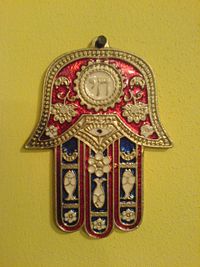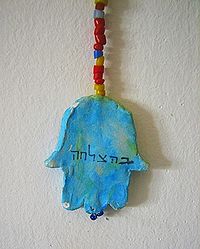- Hamsa
-
This article is about the amulet. For other uses, see Hamsa (disambiguation) and Khamsa (disambiguation).
The hamsa (Arabic: خمسة khamsah, also romanized khamsa, meaning lit. "five") is a palm-shaped amulet popular throughout the Middle East and North Africa, and commonly used in jewellery and wall hangings.[1][2] Depicting the open right hand, an image recognized and used as a sign of protection in many societies throughout history, the hamsa provides superstitious defense against the evil eye. It is also known as the hand of Fatima, so named to commemorate Muhammad's daughter Fatima Zahra. Levantine Christians call it the hand of Mary, for the mother of Jesus. Following its incorporation into Jewish tradition via its widespread use in the Islamic world, it was also renamed the hand of Miriam for Miriam, sister of Moses.
Contents
Name and origins
Hamsa, also romanized khamsa, is an Arabic word that literally means "five", but also "the five fingers of the hand."[3][4][5]
Its exact origins are Sabaeans and the oldest one found in Tylos. A universal sign of protection, the image of the open right hand is seen in Mesopotamian artifacts in the amulets of the Qāt Ištar and the Qāt Inana and in the Buddha's gesture (mudrā) of teaching and protection.[2] Other symbols of divine protection based around the hand include the Hand-of-Venus (or Aphrodite) and the Hand-of-Mary that was used to protect women from the evil eye, boost fertility and lactation, promote healthy pregnancies and strengthen the weak.[2]
One theory postulates a connection between the khamsa and the Mano Pantea (or Hand-of-the-All-Goddess), an amulet known to ancient Egyptians as the Two Fingers. In this amulet, the Two Fingers represent Isis and Osiris and the thumb, their child Horus and it was used to invoke the protective spirits of parents over their child.[2] Another theory traces the origins of the hamsa to Carthage (Phoenicia) where the hand (or in some cases vulva) of the supreme deity Tanit was used to ward off the evil eye.[6]
With the advent of Islam, the khamsa came to be known as the hand of Fatima to commemorate Fatima Zahra, the daughter of the Prophet Muhammad.[7][5] Sources indicate that it is known to Europeans as the "hand of Fatima" or "hands of Fatima", while natives call it by its Arabic name khamsa, khams or khoms.[8][9] Arabs also call the amulet simply al-kaff ( "the hand").[10] According to Bruno Barbatti, while this motif is "the most important apotropaic sign in the Islamic world," many modern day representations continue to "show unmistakably that they derive from sex symbolism."[11]
The hamsa's path into Jewish culture, and its popularity particularly in Sephardic and Mizrahi Jewish communities, can be traced through its use in Islam.[6][2] This "favorite Muslim talisman" became a part of Jewish tradition in North African and Middle Eastern Jewish communities.[12] Jews retained the Arabic name hamsa, but renamed it the hand of Miriam, referencing the sister of the biblical Moses and Aaron, so as not to reference the daughter of the prophet of Islam.[6][5][13]
The khamsa holds recognition as a bearer of good fortune among Christians in the region as well. Levantine Christians call it the hand of Mary (Arabic: Kef Miryam, or the "Virgin Mary's Hand").[14][15] Well after the end of Islamic rule in Spain, its use was significant enough to prompt an episcopal committee convened by Emperor Charles V to decree a ban on the Hand of Fatima and all open right hand amulets in 1526.[2]
Forms, symbolism and usage
The Hand (Khamsa), particularly the open right hand, is a sign of protection that also represents blessings, power and strength, and is seen as potent in deflecting the evil eye.[2][16] One of the most common components of gold and silver jewellery in the region,[7] historically and traditionally, it was most commonly carved in jet or formed from silver, a metal believed to represent purity and hold magical properties.[2][17] It is also painted in red (sometimes using the blood of a sacrificed animal) on the walls of houses for protection,[18][19] or painted or hung on the doorways of rooms, such as those of an expectant mother or new baby.[2] The hand can be depicted with the fingers spread apart to ward off evil, or as closed together to bring good luck.[20] Highly stylized versions may be difficult to recognize as hands, and can consist of five circles representing the fingers, situated around a central circle representing the palm.[20]
Used to protect against evil eye, a malicious stare believed to be able to cause illness, death, or just general unluckiness, hamsas often contain an eye symbol.[21][17] Depictions of the hand, the eye, or the number five in Arabic (and Berber) tradition are related to warding off the evil eye, as exemplified in the saying khamsa fi ainek ("five [fingers] in your eye").[21] Raising one's right hand with the palm showing and the fingers slightly apart is part of this curse meant "to blind the aggressor."[18] Another formula uttered against the evil eye in Arabic, but without hand gestures, is khamsa wa-khamis ("five and Thursday").[22][9] As the fifth day of the week, Thursday is considered a good day for magic rites and pilgrimages to the tombs of revered saints to counteract the effects of the evil eye.[8]
The number five in Islam is connected to the open hand, the pentagram of the five senses, marriage, the Five Pillars of Islam, the five daily prayers, and the hand of Fatima.[2][8] Sufi staffs or poles are often topped with a khamsa.[18] Among Shiites, the fingers of the hand of Fatima also represent the 'five holy persons' of the Prophet's family: Muhammed, Fatima, Ali, Hassan and Hussein.[18][2] Ali's name or those of all of The Twelve Imams are sometimes engraved on metal Hands of Fatima.[18] Hamsas can also include a heart, a hexagram or the word Allah inscribed in the palm of the hand.[9]
Due to its significance in both Arabic and Berber culture, the hamsa is one of the national symbols of Algeria, and appears in its emblem. It is also the most popular of the different amulets to ward off the evil eye in Egypt — others being the Eye, and the Hirz (a silver box containing verses of the Koran).[7] Egyptian women who live in baladi ("traditional") urban quarters often make khamaysa which are amulets made up of five (khamsa) objects to attach to their children's hair or black aprons. The five objects can be made peppers, hands, circles or stars hanging from hooks. Black aprons are also thought to ward off the evil eye.[19]
With the establishment of the State of Israel, the widespread use of the talisman by Jews who came there from Islamic countries declined precipitously. Its association with superstition was out of place in the secularly conceived state, and, according to writer Alexandra Nocke, its 'Easternness' was looked down upon in the Eurocentric Ashkenazi cultural milieu that dominated.[23]
In recent decades, that trend has been reversed with the renewed Israeli interest in Mizrahi folklore and customs and the hamsa's use is proliferating. In Israel today, it is a trendy symbol that has become "an icon of Israeliness and secularity," though its symbolism there is by no means all pervading or universal.[23] A popular 'good luck' charm, it appears on necklaces, keychains, postcards, telephone and lottery cards, and in advertisements.[23]It is also incorporated into high-end jewellery, decorative tilework and wall decorations.[23]
See also
References
- ^ Bernasek et al., 2008, p. 12.
- ^ a b c d e f g h i j k Sonbol, 2005, pp. 355-359.
- ^ Zenner, 1988, p. 284.
- ^ World Institute for Advanced Phenomenological Research and Learning (Belmont, Estados Unidos), 1991, p. 219.
- ^ a b c Drazin, 2009, p. 268.
- ^ a b c Silver, 2008, p. 201.
- ^ a b c Badawi, 2004, p. 510.
- ^ a b c Houtsma, 1993, p. 897.
- ^ a b c Shinar, 2004, p. 117.
- ^ Archetypes and motifs in folklore and literature: a handbook (Illustrated ed.). M.E. Sharpe. 2005. p. 143. ISBN 0765612607, 9780765612601. http://books.google.ca/books?id=Cn6pWMverBIC&pg=PA143&dq=%22hand+of+fatima%22+%22right+hand%22&hl=en&ei=ZQEzTpiOPIGAOtOY_ewL&sa=X&oi=book_result&ct=result&resnum=3&ved=0CDwQ6AEwAg#v=onepage&q=%22hand%20of%20fatima%22%20%22right%20hand%22&f=false.
- ^ Berber Carpets of Morocco: The Symbols Origin and Meaning by Bruno Barbatti, page 205
- ^ Shadur and Shadur, 2003, p. 92.
- ^ Steinmetz, 2005, p. 58.
- ^ Perennial Books, 1970, p. 186.
- ^ Trumball, 1896, p. 77.
- ^ Rajab, 1989, p. 116.
- ^ a b Lynch and Roberts, 2010, p. 8.
- ^ a b c d e Schimmel, p. 92.
- ^ a b Early, 1993, p. 116
- ^ a b Gomez, 1996, p. 54.
- ^ a b Ham and Bing, 2007, p. 385.
- ^ Lent et al., 1996, p. 189.
- ^ a b c d Nocke, 2009, pp. 133-134.
Bibliography
- Badawi, Cherine (2004). Footprint Egypt (4th, illustrated ed.). Footprint Travel Guides. ISBN 9781903471777.
- Bernasek, Lisa; Peabody Museum of Archaeology and Ethnology; Burger, Hillel S. (2008). Artistry of the everyday: beauty and craftsmanship in Berber art (Illustrated ed.). Peabody Museum Press, Harvard University. ISBN 0873654056, 9780873654050.
- Drazin, Israel (2009). Maimonides and the Biblical Prophets. Gefen Publishing House Ltd. ISBN 9652294306, 9789652294302.
- Evelyn A. Early (1993). Baladi women of Cairo: playing with an egg and a stone (Illustrated ed.). Lynne Rienner Publishers. ISBN 1555872689, 9781555872687.
- Gomez, Aurelia (1996). Crafts of Many Cultures: 30 Authentic Craft Projects from Around the World. Scholastic Inc.. ISBN 0590491822, 9780590491822.
- Ham, Anthony; Bing, Alison (2007). Morocco (8th, illustrated ed.). Lonely Planet. ISBN 9781740599740.
- M. Th. Houtsma (1993). M. Th. Houtsma. ed. E.J. Brill's first encyclopedia of Islam, 1913-1936 (Reprint ed.). BRILL. ISBN 9004097902, 9789004097902.
- Lent, J. M.; Bearman, Peri J.; Qureshi, Hakeem-Uddeen (1997). The encyclopaedia of Islam, new edition (2nd ed.). Brill. ISBN 9789004107953.
- Lynch, Patricia Ann; Roberts, Jeremy (2010). African Mythology A to Z (2nd, revised ed.). Infobase Publishing. ISBN 1604134151, 9781604134155.
- McGuinness, Justin (2002). Footprint Tunisia Handbook (3rd, illustrated ed.). Footprint Travel Guides. ISBN 9781903471289.
- Nocke, Alexandra (2009). The place of the Mediterranean in modern Israeli identity (Illustrated ed.). BRILL. ISBN 9004173242, 9789004173248.
- Perennial Books (1970). Studies in comparative religion, Volumes 4-5. University of California.
- Rajab, Jehan S. (1989). Palestinian costume (Illustrated ed.). Kegan Paul. ISBN 9780710302830.
- Schimmel, Annemarie (1994). Deciphering the signs of God: a phenomenological approach to Islam. SUNY Press. ISBN 0791419827, 9780791419823.
- Shadur, Joseph; Shadur, Yehudit (2002). Traditional Jewish papercuts: an inner world of art and symbol (Illustrated ed.). UPNE. ISBN 1584651652, 9781584651659.
- Shinar, Pessah (2004). Modern Islam in the Maghrib. JSAI. ISBN 9657258022, 9789657258026.
- Silver, Alan (2008). Jews, Myth and History: A Critical Exploration of Contemporary Jewish Belief and Its Origins. Troubador Publishing Ltd. ISBN 9781848760646.
- Sonbol, Amira El Azhary (2005). Beyond the exotic: women's histories in Islamic societies. Syracuse University Press. ISBN 0815630557, 9780815630555.
- Trumbull, Henry Clay (1896). The threshold covenant: or, The beginning of religious rites (2nd ed.). C. Scribner's.
- World Institute for Advanced Phenomenological Research and Learning (Belmont, Estados Unidos) (1991). Anna-Teresa Tymieniecka. ed. Roman Ingarden's aesthetics in a new key and the independent approaches of others: the performing arts, the fine arts, and literature, Volume 3. Springer. ISBN 0792310144, 9780792310143.
- Steinmetz, Sol (2005). Dictionary of Jewish usage: a guide to the use of Jewish terms. Rowman & Littlefield. ISBN 0742543870, 9780742543874.
- Zenner, Walter P. (1988). Persistence and flexibility: anthropological perspectives on the American Jewish experience (Illustrated ed.). SUNY Press. ISBN 0887067484, 9780887067488.
Categories:- Amulets
- Fatimah
- Islamic symbols
- Islamic culture
- Jewish mysticism
- Jewish symbols
- Judeo-Islamic topics
- National symbols of Algeria
- Sephardi Jews topics
Wikimedia Foundation. 2010.



